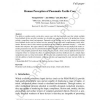Free Online Productivity Tools
i2Speak
i2Symbol
i2OCR
iTex2Img
iWeb2Print
iWeb2Shot
i2Type
iPdf2Split
iPdf2Merge
i2Bopomofo
i2Arabic
i2Style
i2Image
i2PDF
iLatex2Rtf
Sci2ools
AR
2008
2008
Human Perception of Pneumatic Tactile Cues
The ability to combine tactile, on-the-skin, sensory cues with the kinesthetic ones that widely available force-feedback devices are able to produce is a desirable one, opening the door to the production of more realistic, compelling virtual environments. Pneumatic air-jet displays can be easily mounted on existing force-feedback devices and we believe have the potential to provide useful complimentary tactile information. However, there is little concrete psychophysical data relating to pneumatic displays -- a fact that hinders their adoption. This paper addresses this challenge, and presents brief psychophysical studies examining localization rate, the two-point threshold and the stimulus intensity of cues produced by pneumatic air jets. Using insights gained from these studies, we also present a more concrete application-focused investigation where we evaluate the effect of combining tactile and force-feedback cues in a simple object manipulation task in a virtual environment. We s...
| Added | 08 Dec 2010 |
| Updated | 08 Dec 2010 |
| Type | Journal |
| Year | 2008 |
| Where | AR |
| Authors | Yeongmi Kim, Ian Oakley, Jeha Ryu |
Comments (0)

